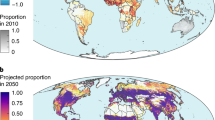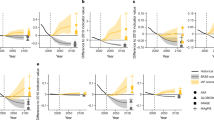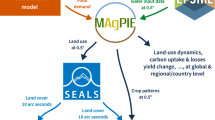Abstract
Several studies have proposed maximum allowable areas of cropland (12.6–15.18% of terrestrial area) as environmental sustainability requirements, yet none have so far considered the minimum biodiversity levels required to support ecosystem functioning at acceptable levels. Here, we use a decision tree-based optimization model to estimate the maximum area of cropland and pasture that would meet—or come closest to meeting—the acceptable levels of local biodiversity proposed in the literature (90% local species abundance and 80% local species richness compared with an undisturbed baseline). We model four scenarios under which we vary two key sources of uncertainty: the maximization function and the potential of secondary vegetation to maintain biodiversity. The model finds that a maximum of 4.62–11.17% of the global ice-free land can be allocated to cropland (and 7.86–15.67% to pasture) to meet these biodiversity constraints—a lower level than was suggested in previous studies. The results are very sensitive to the minimum acceptable biodiversity values and the biodiversity response factors used, but the size of the disparity between current cropland area and our results suggests that actions to limit or reduce the area dedicated to agriculture should feature more prominently in policy discussions.
This is a preview of subscription content, access via your institution
Access options
Access Nature and 54 other Nature Portfolio journals
Get Nature+, our best-value online-access subscription
$29.99 / 30 days
cancel any time
Subscribe to this journal
Receive 12 digital issues and online access to articles
$119.00 per year
only $9.92 per issue
Buy this article
- Purchase on Springer Link
- Instant access to full article PDF
Prices may be subject to local taxes which are calculated during checkout





Similar content being viewed by others
Data availability
The datasets used to generate the land use/land use intensity maps at the subecoregion level, as well as the biodiversity response factors, are freely available in the sources referenced above. Additional data generated and/or analysed during the current study are available from the corresponding author on reasonable request.
Code availability
The code can be made available for replication purposes by the corresponding author on reasonable request.
References
Ellis, E. C. Anthropocene: A Very Short Introduction (Oxford Univ. Press, 2018).
Metzger, M. J., Rounsevell, M. D. A., Acosta-Michlik, L., Leemans, R. & Schröter, D. The vulnerability of ecosystem services to land use change. Agric. Ecosyst. Environ. 114, 69–85 (2006).
Bateman, I. J. et al. Bringing ecosystem services into economic decision-making: land use in the United Kingdom. Science 341, 45–50 (2013).
Balmford, A. et al. Economic reasons for conserving wild nature. Science 297, 950–953 (2002).
Roadmap to a Resource Efficient Europe Report No. COM(2011) 571 (European Commission, 2011).
Maxwell, S. L., Fuller, R. A., Brooks, T. M. & Watson, J. E. Biodiversity: the ravages of guns, nets and bulldozers. Nature 536, 143–145 (2016).
Le Quéré, C. et al. Global carbon budget 2016. Earth Syst. Sci. Data 8, 605–649 (2016).
Houghton, R. A. & Nassikas, A. A. Global and regional fluxes of carbon from land use and land cover change 1850–2015. Glob. Biogeochem. Cycles 31, 456–472 (2017).
Campbell, B. M. et al. Agriculture production as a major driver of the Earth system exceeding planetary boundaries. Ecol. Soc. 22, 8 (2017).
Rockström, J. et al. Planetary boundaries: exploring the safe operating space for humanity. Ecol. Soc. 14, 32 (2009).
Dao, H. et al. Environmental Limits and Swiss Footprints Based on Planetary Boundaries (UNEP/GRID-Geneva & Univ. Geneva, 2015).
Bringezu, S., O’Brien, M. & Schütz, H. Beyond biofuels: assessing global land use for domestic consumption of biomass. Land Use Policy 29, 224–232 (2012).
Heck, V., Hoff, H., Wirsenius, S., Meyer, C. & Kreft, H. Land use options for staying within the planetary boundaries—synergies and trade-offs between global and local sustainability goals. Glob. Environ. Change 49, 73–84 (2018).
Hurtt, G. et al. Harmonization of global land-use change and management for the period 850–2100. Geosci. Model Dev. (in the press).
Steffen, W. et al. Planetary boundaries: guiding human development on a changing planet. Science 347, 1259855 (2015).
Hooper, D. U. et al. A global synthesis reveals biodiversity loss as a major driver of ecosystem change. Nature 486, 105–108 (2012).
Newbold, T. et al. Has land use pushed terrestrial biodiversity beyond the planetary boundary? A global assessment. Science 353, 288–291 (2016).
Newbold, T. et al. Global effects of land use on local terrestrial biodiversity. Nature 520, 45–50 (2015).
Clements, G. R. et al. Where and how are roads endangering mammals in Southeast Asia’s forests? PLoS ONE 9, e115376 (2014).
Weber, E. & Li, B. Plant invasions in China: what is to be expected in the wake of economic development? BioScience 58, 437–444 (2008).
Kremen, C. Managing ecosystem services: what do we need to know about their ecology? Ecol. Lett. 8, 468–479 (2005).
Olson, D. M. et al. Terrestrial ecoregions of the world: a new map of life on Earth. BioScience 51, 933–938 (2001).
Smith, J. R. et al. A global test of ecoregions. Nat. Ecol. Evol. 2, 1889–1896 (2018).
Seto, K. C., Fragkias, M., Güneralp, B. & Reilly, M. K. A meta-analysis of global urban land expansion. PLoS ONE 6, e23777 (2011).
Lenton, T. et al. Tipping elements in the Earth’s climate system. Proc. Natl Acad. Sci. USA 105, 1786–1793 (2008).
Living Planet Report 2018: Aiming Higher (WWF, 2018).
Hill, S. L. L. et al. Reconciling biodiversity indicators to guide understanding and action. Conserv. Lett. 9, 405–412 (2016).
Hoff, H., Nykvist, B. & Carson, M. “Living Well, Within the Limits of our Planet”? Measuring Europe’s Growing External Footprint Working Paper 2014-05 (Stockholm Environment Institute, 2014).
Nykvist, B. et al. National Environmental Performance on Planetary Boundaries (Swedish Environmental Protection Agency, 2013).
Cole, M. J., Bailey, R. M. & New, M. G. Tracking sustainable development with a national barometer for South Africa using a downscaled “safe and just space” framework. Proc. Natl Acad. Sci. USA 111, E4399–E4408 (2014).
Phalan, B., Green, R. & Balmford, A. Closing yield gaps: perils and possibilities for biodiversity conservation. Phil. Trans. R. Soc. B 369, 20120285 (2014).
Baumann, M. et al. Deforestation and cattle expansion in the Paraguayan Chaco 1987–2012. Reg. Environ. Change 17, 1179–1191 (2017).
Bren d’Amour, C. et al. Future urban land expansion and implications for global croplands. Proc. Natl Acad. Sci. 114, 8939–8944 (2017).
Hunter, M. C., Smith, R. G., Schipanski, M. E., Atwood, L. W. & Mortensen, D. A. Agriculture in 2050: recalibrating targets for sustainable intensification. BioScience 67, 386–391 (2017).
Tilman, D., Balzer, C., Hill, J. & Befort, B. L. Global food demand and the sustainable intensification of agriculture. Proc. Natl Acad. Sci. USA 108, 20260–20264 (2011).
Global Bioenergy: Supply and Demand Projections. A Working Paper for REmap 2030 (IRENA, 2014).
Newbold, T. Future effects of climate and land-use change on terrestrial vertebrate community diversity under different scenarios. Proc. R. Soc. B 285, 20180792 (2018).
Oliver, T. H. How much biodiversity loss is too much? Science 353, 220–221 (2016).
Howe, C., Suich, H., Vira, B. & Mace, G. M. Creating win-wins from trade-offs? Ecosystem services for human well-being: a meta-analysis of ecosystem service trade-offs and synergies in the real world. Glob. Environ. Change 28, 263–275 (2014).
Lee, H. & Lautenbach, S. A quantitative review of relationships between ecosystem services. Ecol. Indic. 66, 340–351 (2016).
Gibson, L. et al. Primary forests are irreplaceable for sustaining tropical biodiversity. Nature 478, 378–381 (2011).
Phillips, H. R. P., Newbold, T. & Purvis, A. Land-use effects on local biodiversity in tropical forests vary between continents. Biodivers. Conserv. 26, 2251–2270 (2017).
Jung, M. et al. Local factors mediate the response of biodiversity to land use on two African mountains. Anim. Conserv. 20, 370–381 (2017).
Balmford, A., Green, R. & Phalan, B. Land for food & land for nature? Daedalus 144, 57–75 (2015).
Van Asselen, S. & Verburg, P. H. A land system representation for global assessments and land-use modeling. Glob. Change Biol. 18, 3125–3148 (2012).
ArcGIS Desktop: Release 10 (Environmental Systems Research Institute, 2011).
Kehoe, L. et al. Biodiversity at risk under future cropland expansion and intensification. Nat. Ecol. Evol. 1, 1129–1135 (2017).
Global Agro-ecological Zones (GAEZ v3.0) (FAO & IIASA, 2010).
Suitability of Global Land Area for Pasture (FGGD) (FAO, 2007).
Hurtt, G. C. et al. Harmonization of land-use scenarios for the period 1500–2100: 600 years of global gridded annual land-use transitions, wood harvest, and resulting secondary lands. Clim. Change 109, 117 (2011).
Scheffer, M. Critical Transitions in Nature and Society (Princeton Univ. Press, 2009).
Moreno-Mateos, D. et al. Anthropogenic ecosystem disturbance and the recovery debt. Nat. Commun. 8, 14163 (2017).
Jones, H. P. & Schmitz, O. J. Rapid recovery of damaged ecosystems. PLoS ONE 4, e5653 (2009).
Jones, H. P. et al. Restoration and repair of Earth’s damaged ecosystems. Proc. R. Soc. B 285, 20172577 (2018).
Acknowledgements
A.U.-L. acknowledges support from the UCL ISR Doctoral Studentship. A.U.-L. thanks T. Newbold (UCL CBER) and I. Butnar (UCL ISR) for helpful exchanges when producing an earlier version of the paper. T. Newbold also helped with the original design of the study. G.M.M. acknowledges the Sustainable and Healthy Food Systems (SHEFS) programme supported by the Wellcome Trust’s ‘Our Planet, Our Health’ programme (grant no. 205200/Z/16/Z).
Author information
Authors and Affiliations
Contributions
A.U.-L. conceived the study idea, collected and analysed the data, and wrote the original draft. A.U.-L., G.M.M. and P.E. reviewed and edited the manuscript. P.E. supervised the study.
Corresponding author
Ethics declarations
Competing interests
The authors declare no competing interests.
Additional information
Publisher’s note: Springer Nature remains neutral with regard to jurisdictional claims in published maps and institutional affiliations.
Supplementary information
Supplementary Information
Supplementary discussion, Tables 1–3, Figs. 1–13 and references 1–7
Rights and permissions
About this article
Cite this article
Usubiaga-Liaño, A., Mace, G.M. & Ekins, P. Limits to agricultural land for retaining acceptable levels of local biodiversity. Nat Sustain 2, 491–498 (2019). https://doi.org/10.1038/s41893-019-0300-8
Received:
Accepted:
Published:
Issue Date:
DOI: https://doi.org/10.1038/s41893-019-0300-8



